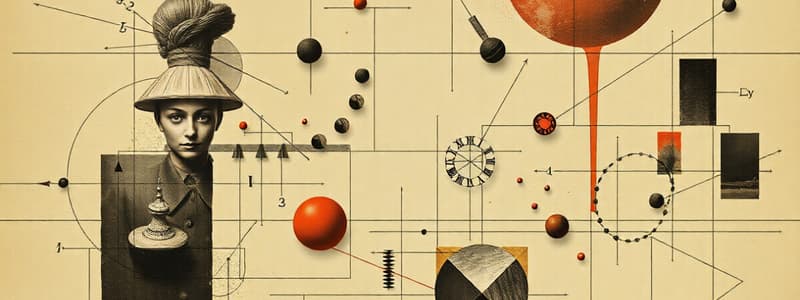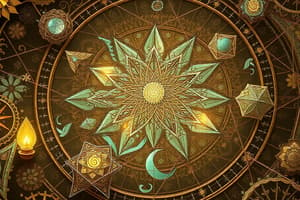Podcast
Questions and Answers
Which statement best describes the relationship between pure and applied mathematics?
Which statement best describes the relationship between pure and applied mathematics?
- Pure mathematics often leads to later discoveries of practical applications, blurring the line between the two. (correct)
- Applied mathematics is considered more valuable due to its direct impact on other fields.
- Pure mathematics focuses solely on practical applications, while applied mathematics explores theoretical concepts.
- They are entirely separate disciplines with no overlap in research or application.
How did the Islamic scholars contribute to the development of mathematics during the Middle Ages?
How did the Islamic scholars contribute to the development of mathematics during the Middle Ages?
- They discarded Greek mathematical texts and started fresh.
- They focused solely on applied mathematics for practical purposes.
- They regressed mathematical understanding, causing a slowdown.
- They preserved and translated Greek texts, while also advancing fields like algebra and trigonometry. (correct)
What is the significance of the axiomatic method introduced by Euclid?
What is the significance of the axiomatic method introduced by Euclid?
- It promotes intuition over logical deduction.
- It relies solely on empirical observation and experimentation.
- It establishes a system of definitions, axioms, theorems, and proofs for mathematical reasoning. (correct)
- It restricts mathematical study to practical applications.
What distinguishes discrete mathematics from other branches of mathematics?
What distinguishes discrete mathematics from other branches of mathematics?
How did the invention of computers impact the field of mathematics?
How did the invention of computers impact the field of mathematics?
Which of the following statements accurately describes the relationship between mathematics and empirical sciences?
Which of the following statements accurately describes the relationship between mathematics and empirical sciences?
The development of non-Euclidean geometry by mathematicians like Bolyai, Lobachevsky, and Riemann challenged which long-held belief?
The development of non-Euclidean geometry by mathematicians like Bolyai, Lobachevsky, and Riemann challenged which long-held belief?
What was a key contribution of the ancient Mesopotamians to mathematics?
What was a key contribution of the ancient Mesopotamians to mathematics?
What was the significance of the works of Cardano and Tartaglia in the 16th century?
What was the significance of the works of Cardano and Tartaglia in the 16th century?
What role does set theory play in modern mathematics?
What role does set theory play in modern mathematics?
Flashcards
What is Mathematics?
What is Mathematics?
The study of quantity, structure, space, and change.
Mathematical Theorems
Mathematical Theorems
Statements that are proven to be true using mathematical proofs.
Pure Mathematics
Pure Mathematics
Mathematics done for its own sake, without regard to application.
Applied Mathematics
Applied Mathematics
Signup and view all the flashcards
Mathematical
Mathematical
Signup and view all the flashcards
Sexagesimal System
Sexagesimal System
Signup and view all the flashcards
Analytic Geometry
Analytic Geometry
Signup and view all the flashcards
Calculus
Calculus
Signup and view all the flashcards
Discrete Mathematics
Discrete Mathematics
Signup and view all the flashcards
Set Theory
Set Theory
Signup and view all the flashcards
Study Notes
- Mathematics explores quantity, structure, space, and change.
- Mathematicians and philosophers hold varying views on the scope and definition of mathematics.
- Mathematicians identify patterns and create new conjectures.
- Mathematical proofs are used to validate or invalidate conjectures.
- Mathematical research is essential for solving mathematical problems.
- Mathematics plays a vital role in natural science, engineering, medicine, finance, and social science.
- Applied mathematics has created entirely new mathematical disciplines.
- Pure mathematics is pursued by mathematicians for its intrinsic value, without specific applications in mind.
- The distinction between pure and applied mathematics is not always clear, as pure mathematics often finds practical applications later.
Etymology
- The word "mathematics" originates from the Greek term "máthēma," meaning "knowledge, study, learning."
- "Mathematical" is the adjective form, signifying "relating to mathematics."
- "Math" is a shortened form of "mathematics" commonly used in North America.
History
- The history of mathematics involves an ongoing progression of abstractions.
- Mathematical and logical abstraction existed long before the modern era.
- Practical problems have historically stimulated mathematical advancements.
- The pursuit of mathematics for its inherent value has also driven its development.
- Statistics and game theory are closely linked to their applications and are often categorized as applied mathematics.
- Pure mathematics is developed independently of applications, but practical uses often emerge later.
Ancient history
- Plimpton 322 (Babylonian mathematics c. 1900 BC), the Rhind Mathematical Papyrus (Egyptian mathematics c. 1650 BC), and the Moscow Mathematical Papyrus (Egyptian mathematics c. 1850 BC) are among the oldest mathematical texts available.
- These texts all address the Pythagorean theorem and Pythagorean triples.
- Following basic arithmetic, geometry, and algebra this seems to be the most prevalent and earliest mathematical development.
- Ancient Mesopotamian mathematics began around 6000 BC.
- A sexagesimal (base 60) numeral system was developed in ancient Mesopotamia.
- The people of ancient Mesopotamia created calculation and measurement techniques.
- Multiplication, reciprocals, square roots, and cube roots could all be calculated using Mesopotamian methods.
- Algebraic equations were solved using methods developed for practical problems in ancient Mesopotamia.
- The ancient Egyptians made advances in arithmetic, geometry, and surveying.
- The ancient Egyptians used a decimal system.
- Practical problems involving land area, volumes, and bread were solved by the ancient Egyptians.
- The ancient Greeks initiated a methodical study of mathematics as a distinct subject, beginning around 600 BC.
- Greek mathematics was built upon logical reasoning and proofs, particularly in geometry.
- The axiomatic method, consisting of definitions, axioms, theorems, and proofs, was introduced by Euclid (c. 300 BC).
Middle Ages
- Mathematics slowed down in Europe during the Middle Ages.
- The Islamic world actively developed mathematics.
- Arabic translations and preservation of Greek mathematical texts were undertaken by Islamic scholars.
- Islamic scholars further developed mathematics.
- Islamic mathematicians made significant progress in algebra, trigonometry, and number theory.
- A complete solution to the quadratic equation was provided by Islamic mathematicians.
- The study of conic sections was initiated by Islamic mathematicians.
- Trigonometric functions were introduced by Islamic mathematicians.
- Islamic mathematicians used trigonometric functions in astronomy.
- Spherical geometry was developed by Islamic mathematicians.
- A renewed interest in mathematics emerged during the Renaissance (15th century).
- Latin translations of Greek and Arabic mathematical texts were produced by mathematicians.
Renaissance to early modern
- Advancements in algebra in Europe were aided by mathematicians such as Gerolamo Cardano and Niccolò Tartaglia, who worked on cubic equations in the 16th century.
- Nicolaus Copernicus (1473–1543) proposed a heliocentric model, placing the Sun at the center of the universe.
- Johannes Kepler (1571–1630) sought to describe planetary motion mathematically.
- René Descartes (1596–1650) developed analytic geometry.
- Geometric shapes can be described with algebra through analytic geometry.
- Isaac Newton (1643–1727) developed calculus.
- Gottfried Wilhelm Leibniz (1646–1716) developed calculus independently.
- Calculus became a vital tool in physics and engineering.
- Science and technology saw increasing importance of Mathematics.
Modern period
- In the 19th century, mathematics became increasingly abstract.
- Mathematics placed more focus on logic.
- Non-Euclidean geometry was developed by mathematicians like János Bolyai, Nikolai Lobachevsky, and Bernhard Riemann.
- Group theory was advanced by mathematicians such as Évariste Galois and Niels Henrik Abel.
- Georg Cantor developed set theory
- Set theory established an abstract basis for mathematics.
- Set theory is applied to define mathematical objects, and prove theorems.
- Rigor gained prominence in the 19th century.
- Mathematicians such as Karl Weierstrass specialized in providing correct definitions and proofs.
- Since the 20th century, mathematics has been developing rapidly.
- Computers enabled new discoveries, mainly in applied mathematics.
- Statistics and game theory have risen in prominence as new fields.
Notation, terminology, and style
- Notation is essential to mathematics.
- Symbols are used to represent mathematical objects and ideas.
- Mathematical notation can be field-specific.
- The Hindu–Arabic numeral system is currently the most prevalent mathematical notation.
- The evolution of mathematical notation has occurred over centuries.
- Mathematical notation is beneficial to professionals although daunting to beginners.
- Mathematical jargon may be present in a mathematical statement.
- Numerous mathematical terms have Greek and Latin roots.
Mathematics as a science
- Carl Friedrich Gauss referred to mathematics as the Queen of the Sciences.
- Mathematics does not rely on empirical observation and experimentation unlike science.
- Mathematics shares some similarities with the empirical sciences.
- Observation or experimentation can motivate some mathematical work.
- Mathematics also investigates the implications of its assumptions.
- Logic and intuition are employed in mathematics.
- Applied mathematics uses models to test predictions against reality.
Fields of mathematics
- Arithmetic, algebra, geometry, trigonometry, calculus, statistics, topology, and mathematical analysis are the main fields of mathematics.
- The study of numbers and their operations is arithmetic.
- The study of mathematical symbols and the rules for manipulating them is algebra.
- The study of shapes, sizes, and positions of objects is geometry.
- The study of the relationships between the sides and angles of triangles is trigonometry.
- The study of continuous change is calculus.
- The study of data collection, analysis, interpretation, presentation, and organization is statistics.
- The study of geometric object properties that remain constant under continuous deformations is topology.
- The study of calculus concepts and techniques is mathematical analysis.
Discrete mathematics
- Discrete mathematics focuses on mathematical structures that are discrete rather than continuous.
- Objects in discrete mathematics possess distinct, separated values.
- Combinatorics, graph theory, coding theory, and cryptography are included in discrete mathematics.
Foundations and philosophy
- Mathematical logic and set theory were developed to clarify the foundations of mathematics.
- Mathematical logic studies of the foundations of mathematics using formal logic.
- Set theory is the branch of mathematics, studying sets.
- Set theory is used to define mathematical objects and prove theorems.
- The philosophy of mathematics is subject to diverse perspectives.
Pure versus applied mathematics
- Mathematics has been categorized into pure and applied mathematics during the 20th century.
- Pure mathematics studies mathematics for its own sake.
- Applied mathematics studies mathematics for applications in other fields.
- There is considerable overlap between pure and applied mathematics in practice.
- Many mathematicians have an interest in both pure and applied mathematics.
- The main focus of pure mathematics is to discover mathematical truths.
- The main focus of applied mathematics is to develop tools for use in other fields.
Awards and prize problems
- Numerous awards are presented for exceptional contributions to mathematics.
- The Fields Medal and the Abel Prize are among the most prestigious awards in mathematics.
- Mathematics also features many prize problems, such as the Millennium Prize Problems.
- The Clay Mathematics Institute selected the seven Millennium Prize Problems in 2000.
- A USD 1,000,000 award is granted for correctly solving any of the problems.
Studying That Suits You
Use AI to generate personalized quizzes and flashcards to suit your learning preferences.



